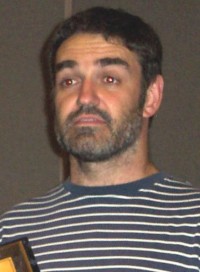 Home > Bart Beaty's Conversational Euro-Comics
Home > Bart Beaty's Conversational Euro-Comics Hante, Philippe Dupuy
posted August 3, 2005
Hante, Philippe Dupuy
posted August 3, 2005


In many ways,
Hante (Cornelius) is the most unexpected comic book of the year. After more than two decades as a professional cartoonist, Philippe Dupuy has finally produced his first solo-authored book. Moreover, as autobiography, it is less about the quotidian aspects of his life than his state of mind. A clear departure from the terrain of M. Jean, the light-hearted character for which he is best known,
Hante is a book that pulls no punches, pushing autobiographical comics in new directions.
 Hante
Hante is the first time that Dupuy, one half of the two-headed comics monster known as Dupuy/Berberian, has produced a book exclusively on his own. The last time we saw his solo work was in 1994's
Journal d'un album (L'Association), in which he alternated autobiographical chapters with Charles Berberian. In that work, Dupuy presented himself as a man beset by demons and overcome with personal problems: his marriage was on shaky ground, his niece passed away, as did his mother. It was clearly a dark period in Dupuy's life, and his work in
Journal carried a somber tone.
Ten years later,
Hante is not much lighter in spirit. The book is a series of short pieces -- not stories as much as slices of life, or rather slices of emotion. The book is structured by Dupuy's daily jogging, and the conversations that he has with himself on his runs through the streets of Paris. These range from the realist to the fantastic. In one piece, Dupuy jogs with the ghost of his mother. In another, he winds up in the stomach of a turtle while talking to a blind woman. In a great one, he ends up in the home of a talking duck, whose primitivist tastes in art make his small home reminiscent of Andre Breton's apartment, reconstituted in the Pompidou Centre. To my mind, the best of the running sequences finds Dupuy in a museum with a talking dog ("not empty, available"). The gap between the possibilities and the realities for the contemporary cartoonist seems palpable on these pages. I was reminded that it's a one block walk from Superheroes (Paris' best comic book store) to the Pompidou Centre, but in terms of public perception, the art forms represented by each remain separated by a far, far greater distance.

The non-jogging pieces in Hante still present that sense of fleetingness. There are dreams and nightmares galore. Several of the pieces are extremely troubling. One finds the author growing rats in his stomach and then vomiting them up. Another wordless strip depicts the death of a dog who is trapped in a legtrap. These are truly disturbing short works that serve to heighten the tension in the more introspective and light-hearted jogging pieces, suggesting, as they do, the underlying psychological issues in the other strips. The two-part "Les amis de la foret" is disturbing in an entirely different manner. Using cute anthropomorphic forest animals, Dupuy depicts the relationship between a close-knit group and their depressive friend. This is an extremely depressing short work, unrelenting in its negativity and the pain that reverberates throughout the space of the story. At the same time, the final story, "Lucha Libre", seems to offer a way out of the darkness. The story of masked Mexican wrestler adjusting to the promise of love offers a significant ray of hope in the darkness, mitigating (somewhat) the overall tone of the book.
Visually, the book is somewhat different from Dupuy's best-known work. Much of it is drawn in a casual, sketchy manner befitting such an intimate journal. Dupuy is clearly opting for a direct expression here that is deliberately minimized in books like the
M. Jean series. The directness of linework really works to heighten the emotional expressivity of
Hante, and gives it a conversational and confessional feeling.

As I say, an unexpected work in many ways. Autobiographical, but in an unusual way -- telling us little about what the author generally does, and a lot about the way that he feels. This book feels a lot more honest than most autobiographical comics, and therefore a lot more difficult. The first time that I read it, I will admit, I was somewhat thrown -- as if this were all too much, and it was a little too dark. Re-reading it in the cold light of day, however, I was struck at how smartly the connections are made between stories, and how skillfully Dupuy has balanced the elements here. There is not a single sop to the market, not a single concession to an audience hoping for a light-hearted romp. This is an important book by an artist we thought we knew well, but in reading this, we realize that autobiography can mask as much as it reveals, disturbing our belief that we can ever really know anyone through art -- or, just maybe, suggesting that we know too much.


